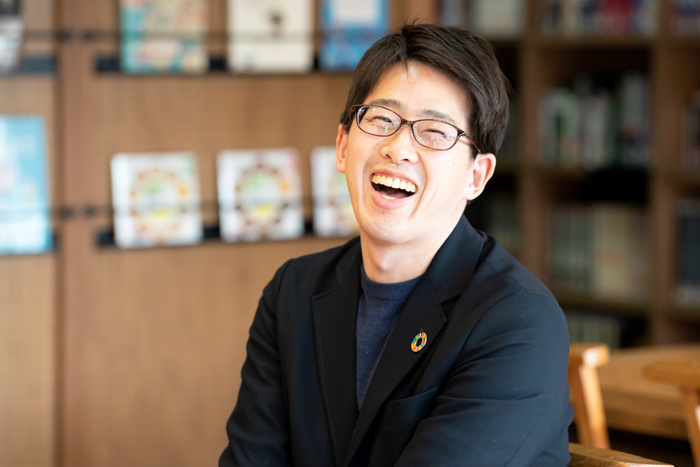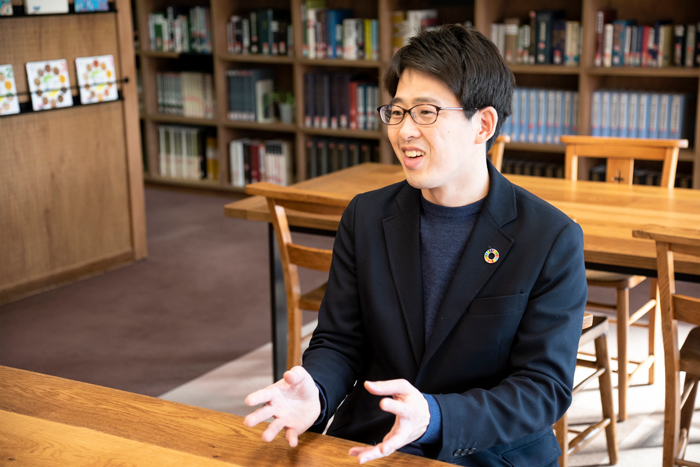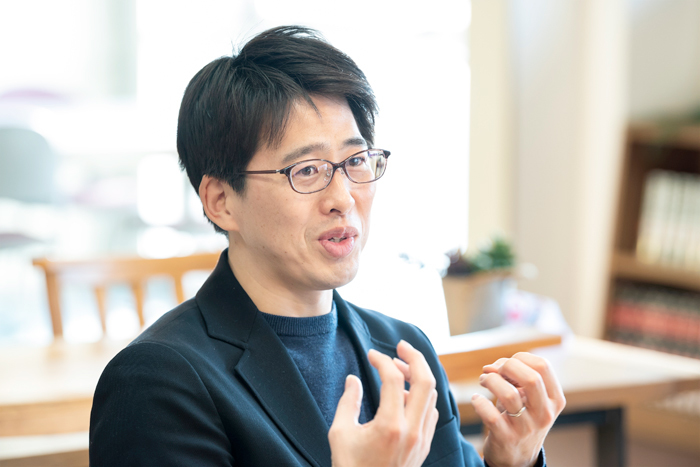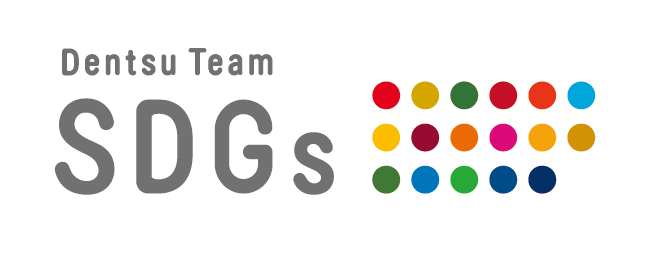Kids take the SDGs more seriously than adults think.
Achieving the SDGs requires the commitment of every generation. While various stakeholders are taking action, the SDGs are not someone else's problem for the children who will be active members of society by the 2030 target date—indeed, they are especially relevant for these children.
This time, we interviewed Ryobun Santō, a school designer who incorporates SDGs into classroom lessons. From his insights, we gained valuable hints for engaging children in SDGs work.

Using SDGs as a window reveals the connection between classroom learning and societal challenges
──After 15 years as a biology teacher at a Tokyo metropolitan high school, you began teaching biology at Nitobe Bunka Elementary, Junior High, and High School in Tokyo in 2019, incorporating SDGs into your lessons. First, could you tell us what sparked your own interest in the SDGs?
Yamato: Even during my time as a teacher at a metropolitan high school, I questioned education focused solely on university entrance exams and the "knowledge-cramming" style where teachers lecture unilaterally. I don't reject traditional education entirely, but I believed schools could exist that educate with different values. I wanted to create lessons where students took the lead and could tangibly feel the connection between what they learned at school and society.
To realize this ideal, I've tried various approaches. For example, designing interactive lessons centered on student-teacher dialogue. After students answer my questions, I respond to their questions. Repeating this cycle helps students generate their own questions and develop the skills to solve them.
To help students understand the connection between learning and society, I've also held classes where working professionals came as guest speakers to share how their biology lessons in school connected to their current jobs. Next year, I plan to implement such classes online as well.
Through my classes, I want students to discover the meaning and joy of learning. This desire fueled my growing passion: "I want to connect society and education more deeply," and "I want to connect diverse adults engaged in social activities for people's futures and the planet with children rich in sensitivity." Around 2012, I began meeting various stakeholders outside of work hours and actively seeking communication.
I frequently attended CSR and CSV study sessions involving companies and NPO/NGO representatives. That's when I noticed, "SDGs are becoming a hot topic..." The more I heard about them, the more my interest grew. So, I spent about a year learning through corporate study sessions and university courses, gradually incorporating them into my lessons starting around summer 2016.
──So you've been utilizing the SDGs in your classes for four years now. As a biology teacher, what aspects of the SDGs appealed to you, Professor Yamafuji?
Yamato: I feel the SDGs encompass everything. That includes various social issues, but also the individual interests and aspirations of each student—ultimately, they all seem connected to the better future the SDGs envision. Plus, each SDG goal is clear and relatable to children.
Even before encountering the SDGs, I sometimes covered environmental issues in class. Biology and the environment are highly compatible, so they integrate well into the curriculum. However, linking other social issues—like poverty, economic growth, or building the foundations for industry and technological innovation—to biology is a bit more challenging.
But by focusing on "connections" – one of the core elements of the SDGs – we can see how environmental issues relate to other challenges. This ultimately strengthens the significance of studying biology. Using the SDGs as a window to structure lessons allows me to connect with students who have diverse perspectives.
Using the SDGs as a window allows students to envision connecting their personal interests with the future. It also deepens the meaning of studying biology for solving societal challenges... Recognizing these various attractions, I began utilizing the SDGs in my lessons.

Combining children's unconstrained ideas with corporate implementation capabilities
──What kind of lessons incorporating SDGs does Mr. Yamafuji conduct?
Yamato: In April, we start by helping students understand why they study biology. Using newspapers and other sources to analyze social issues and current trends, we examine textbook content and think together about how biology learning connects to the SDGs. Then, students discuss what they personally want to explore deeply.
When incorporating SDGs into lessons, I don't make them memorize how many goals or targets there are, or commit each one to memory. Nor do I force them by saying, "Come up with a solution for social issue number X." Instead, each student considers which SDG goal matters most to them personally and what they'd like to try to solve the issue.
When a student says, "I want to try this!", I introduce them to stakeholders I regularly communicate with. I advise them on what might be possible with these companies or organizations, connecting their ideas to action.
──So you link the students' "I want to try this" feelings to the various options you have, Mr. Yamafuji. What kinds of actions do the students take?
Yamato: For example, regarding concrete ethical consumption measures, some students proposed an idea to the food industry: adding messages about the global environment to Valentine's Day chocolates.
Students interested in reducing plastic use have also presented ideas to companies, like creating vending machines that dispense drinks into reusable bottles.
One current project involves satoyama conservation activities in Hinohara Village, Tokyo. It's a challenge to reclaim abandoned farmland, cultivate local crops and organic cotton, and aim for sixth-sector industrialization—covering everything from processing to sales.
──Through these various projects, how have stakeholders reacted to students seriously engaged with the SDGs?
Yamato: The students' creativity is truly outstanding. I'm often surprised by the unexpected directions and ideas they come up with. Moreover, when they pitch these ideas to companies, it's not uncommon for the other party to nod in agreement, saying, "That makes sense." Furthermore, the children's pure, non-business-driven ideas often remind corporate representatives of their original intentions and lead them to reevaluate their company's social value.
Companies possess implementation capabilities and extensive connections that students lack, and that's something we should respect. On the other hand, students have the powerful weapon of pure, unconstrained thinking. By combining each other's strengths, I feel we can often cultivate projects that reach a higher level.

Building a flat relationship with children and tackling challenges together
──I felt Mr. Yamafuji's story offered hints for working on SDGs with the younger generation. Are there things you pay attention to when working with students?
Yamato: Avoid turning projects into one-off events. When I first started incorporating SDGs into lessons, it sometimes felt like we'd take action once and then it was over. That happened because we adults were too controlling. If students aren't genuinely motivated to "do it themselves," they'll struggle and give up halfway.
To make SDGs projects sustainable for children, it's crucial that adults don't over-structure the process. Even during discussions, adults tend to speak up first because we have more knowledge and experience. Just waiting a little longer can sometimes bring out ideas adults wouldn't have thought of.
Another thing I always keep in mind is maintaining a flat relationship, not a teacher-student hierarchy, and never forgetting the attitude of thinking together about the challenges of a world without clear answers. For that, empathy on a personal level, unrelated to the SDGs, is crucial.
When I first meet children, I make an effort to let them understand what kind of person Yamato Tabiko is. I share personal stories: "I'm just an ordinary father of two kids," "Yesterday I met up with some friends and had a great time," "Back in high school, I was in the rugby club, chasing the ball with all my might." Then I explain that on top of being that person, I also have the title of teacher, and now I'm involved in activities that multiply society and education.
When working alongside students, opinions sometimes clash. But if we understand and empathize with each other as people, students can speak their minds boldly and engage without feeling intimidated.
──Indeed, in today's world, "empathy" has become a crucial keyword for both people and companies. Building the foundation of human relationships is vital for children to engage with the SDGs spontaneously. Finally, could you share a message for adults who want to work on the SDGs with children going forward?
Yamato: Children have stamina and boundless energy. It's a waste to keep such powerful beings confined to school all the time. If they collaborate with various stakeholders, they can generate amazing ideas and become a major driving force for solving social issues. I think it would be fascinating if more adults created opportunities to connect with them and truly listen to what they have to say.
 TeamSDGs collaborates with various SDG stakeholders to disseminate information about the SDGs and plan/develop solutions.
TeamSDGs collaborates with various SDG stakeholders to disseminate information about the SDGs and plan/develop solutions.
※See also Professor Tabiko Yamafuji's article here:
"The SDGs" serve as a bridge connecting school learning and society ~ School Designer Professor Tabiko Yamafuji
Was this article helpful?